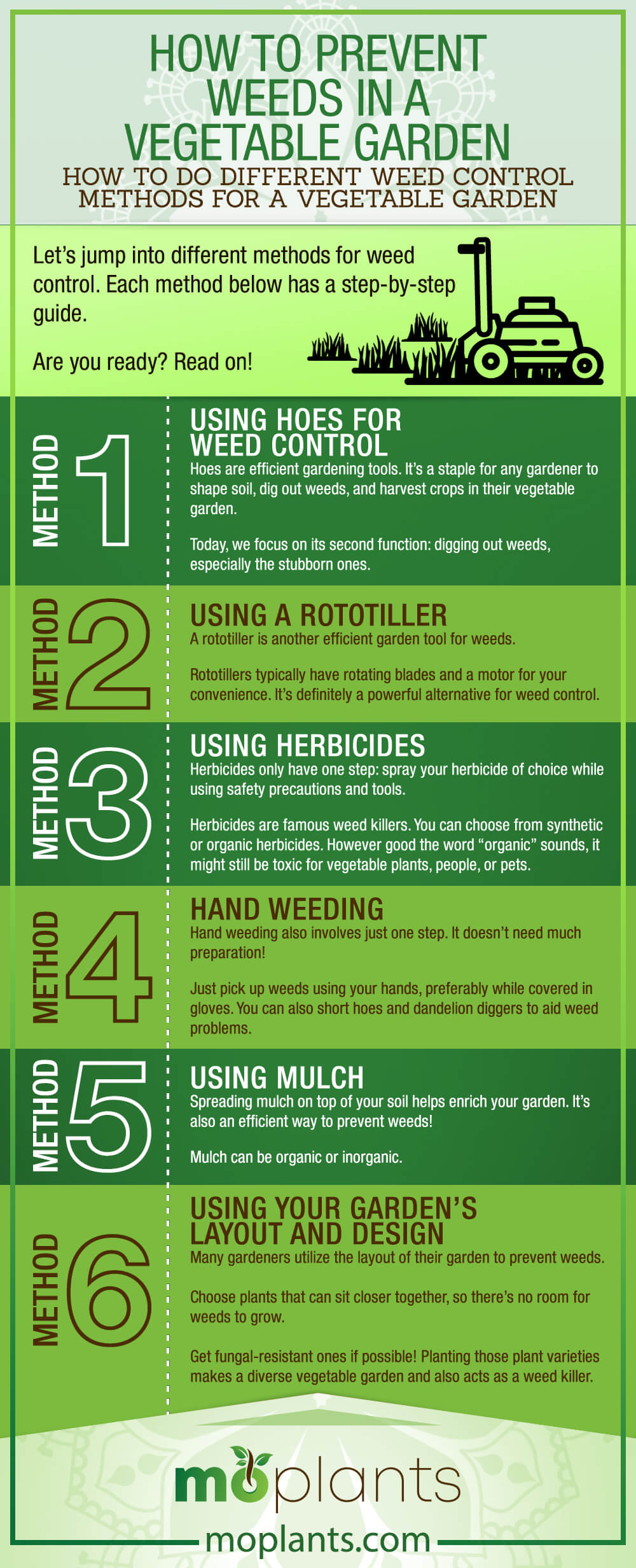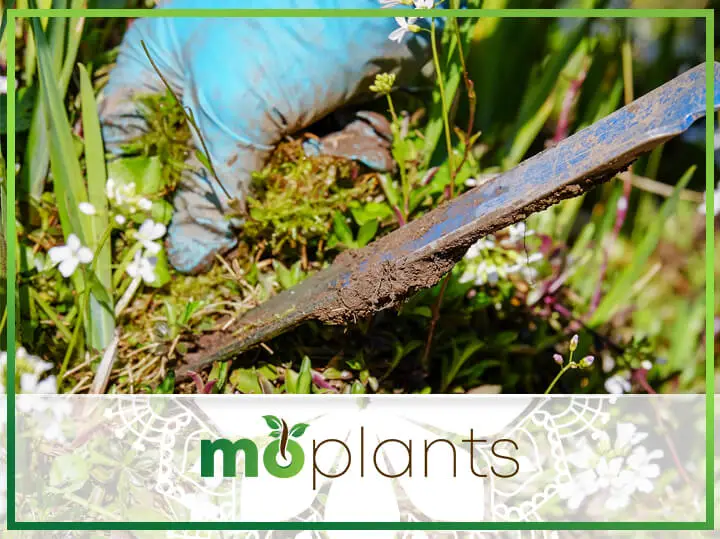Weeds can confuse any gardener. You encounter them whenever you’re gardening, and it may now seem more of a nuisance than ever. Whatever you do, it may seem like there’s no way out.
You face different weeds: wild violets, onion and garlic, dandelions, and poison ivy. You’ve tried all the methods, too – or have you?
There may be some weed control tips and methods you’ve missed out on.
This article is a comprehensive guide to all weeding methods. Plus, you get some bonus ways on how to prevent weeds in a vegetable garden!
What You’ll Need:
- Hoes (optional)
- Rototiller (optional)
- Gloves
- Goggles
- Herbicides (optional)
- Organic or inorganic mulch
- Clear plastic
The optional tools are for the different methods you can use for weeding your vegetable garden.
Gloves and goggles are necessary whether you do hand weeding or not – make sure you always protect yourself.
Meanwhile, the mulch and plastic are for the other preventative methods we discuss below.
How to Do Different Weed Control Methods for a Vegetable Garden
Let’s jump into different methods for weed control. Each method below has a step-by-step guide.
Are you ready? Read on!
Method 1: Using Hoes for Weed Control
Hoes are efficient gardening tools. It’s a staple for any gardener to shape soil, dig out weeds, and harvest crops in their vegetable garden.
Today, we focus on its second function: digging out weeds, especially the stubborn ones.
Step #1: Do Ample Preparation
If you don’t have a hoe at your disposal, buy one at the local shop. There are many different types for you to consider.
Paddles and blades vary depending on function. What you choose is up to you. It largely depends on how big your vegetable garden is and how many weeds cover that space.
Schedule when you want to get rid of weeds. When using a hoe for weed control, do so when the soil is dry. Dry soil creates dust mulch, which prevents new weeds from germinating.
Step #2: Sweep, Slice, and Adjust Accordingly
Sweep your hoe over the weeds to get rid of the tops. Slicing may also work. You want to dig your hoe a bit under the soil to cut them completely.
You also make sure no new weeds will crop up. You bring weed seeds to the surface, too.
If your garden space can’t accommodate broad, sweeping motions, consider getting a shorter hoe. If the weeds are large, opt for a longer, larger hoe as well.
Consider how much space you have and how many weeds there are when you get the right hoe for a weed-free vegetable garden!
Method 2: Using a Rototiller
A rototiller is another efficient garden tool for weeds.
Rototillers typically have rotating blades and a motor for your convenience. It’s definitely a powerful alternative for weed control.
It saves more time compared to hand weeding or using a hoe. However, it can become expensive!
Step #1: Decide on the Tiller Size
Where are you planting? What type of soil is in your garden? Ask these questions before choosing a tiller for your weeds.
You want something ideal for your lot size. Go for something lightweight if your garden is more compact. Then, get something more powerful if you need to kill a lot of weeds.
Keep safety in mind, too. Use the right machine for weed control.
Step #2: Position, Push, and Repeat
Position your rototiller on the soil. Let the tines dig a bit underneath, then turn your machine on.
Stay steady and have a firm grip as you push the rototiller machine through the soil. Repeat as necessary.
Method 3: Using Herbicides
Herbicides only have one step: spray your herbicide of choice while using safety precautions and tools.
Herbicides are famous weed killers. You can choose from synthetic or organic herbicides. However good the word “organic” sounds, it might still be toxic for vegetable plants, people, or pets.
Many people consider using herbicides as a last result because of possible toxicities. Keep this in mind, and take extra care to prevent weeds!
Method 4: Hand Weeding
Hand weeding also involves just one step. It doesn’t need much preparation!
Just pick up weeds using your hands, preferably while covered in gloves. You can also short hoes and dandelion diggers to aid weed problems.
Hand weeding is inexpensive, but it involves a lot of time and labor. Take this into consideration before doing hand weeding.
Method 5: Using Mulch
Spreading mulch on top of your soil helps enrich your garden. It’s also an efficient way to prevent weeds!
Mulch can be organic or inorganic.
For organic mulch, a gardener can use wheat straw, grass clippings, pine needles, wood chips, shredded bark, sawdust, and leaves.
Inorganic mulch includes landscape fabric, such as geotextiles and black plastic. You can even use newspaper!
Two to three inches of mulch is enough for your garden. Don’t pile mulch on the base of your plants! Just one layer of mulch is good for controlling weeds.
Make sure to get rid of weeds beforehand. Use mulch in between vegetable rows as a preventative solution.
Mulch blocks sunlight to discourage weed seeds from germinating and growing on the soil.
Method 6: Using Your Garden’s Layout and Design
Many gardeners utilize the layout of their garden to prevent weeds.
Choose plants that can sit closer together, so there’s no room for weeds to grow.
Get fungal-resistant ones if possible! Planting those plant varieties makes a diverse vegetable garden and also acts as a weed killer.
Have an irrigation system in place to get water where it’s needed. Maybe you can try out a soaker hose irrigation system and the like.
This way, you water only the base of the garden beds, herb plants, vegetables, and more. This way, you don’t water weeds and let them grow.
Get plants with high heights and low heights to shade plants and cover the ground.
With this method, you get your garden to work with you instead of repeatedly attacking it with herbicides and tools!
Infographic

Tips and Tricks: Weed Seeds and Weed Control for Your Vegetable Garden
Now that we’re all done with the different methods to prevent weeds in your garden, we still have some tips and tricks for you.
Maximize the health of all your vegetable gardens with the following:
Tip #1: Solarize Plant Beds
If you run out of weed prevention methods, consider turning to a natural resource: the sun. It’s free and environmentally-friendly!
Make sure to clear your soil and water it first. More moisture means more heat retention.
After clearing your soil and watering it, set down a piece of clear plastic for cover. Leave it on for a month during summer.
The clear plastic lets the sunlight in, and it will make your soil healthier. Aside from preventing weeds, the clear plastic and sunlight combination kills soil-borne diseases.
If you don’t have any clear plastic, a thin layer will suffice. Just make sure not to use opaque plastic, like black plastic! Heat won’t work then.
However, the time you take to solarize the soil surface takes time away to grow your plants.
If you can sacrifice a large area of your garden, then do solarization. If you can’t find a way to do so, maybe other methods are good for you.
Tip #2: Don’t Let Weeds Go to Seed in the First Place
There aren’t going to be any weeds to pull out of the soil if you don’t let weed growth happen in the first place. Getting seeds to the surface of the soil is as good as planting the weeds yourself.
Cut off the tops of weed plants! Prevent seed heads from germinating and growing.
This way, you don’t have to dig up entire weeds under the soil. You minimize the effort involved. Mow or use a hand scythe.
Tip #3: Install A Weed Barrier
We’ve discussed organic mulches above. Utilize inorganic mulches like landscape fabric or black plastic for the best gardening experience.
Use this weed barrier in between garden rows.
You can also use recyclable materials such as newspaper and cardboard. Use a single layer of cardboard or six to seven sheets of newspaper.
While layers of barriers can suppress weed seed germination, it won’t stop them from growing in whatever season.
After you plant your crops and install newspaper, cardboard, fabric, or plastic, pick weeds from the barrier weekly. Remove it at the end of the growing season.
Tip #4: Turn Weeds Into a Compost Pile
Wondering what to do after you take out the weeds? Put your weeds into a compost pile. You eradicate the weeds and let your soil absorb nutrients.
Hot Compost
You can use hot composting for your garden weeds. Heat the pile to 145 degrees Fahrenheit and turn it as regularly as possible.
You also benefit more from your compost heap if you do hot composting during the summer season. The same concept applies if you live near a sunny location.
Hot composting can be time-consuming. Once working, turning, and mixing the pile no longer results in it heating up, you can spread it.
Cool Compost
If you can’t do hot composting, utilize cool composting.
Cool composting, however, can take longer. Cool composting requires you to put a fresh layer of material on top of the heap.
Despite heat not being that much of a factor, your compost heap benefits more if you prebake the weed pile. You need to kill all roots and seeds.
Weed Soup
If neither of the above methods appeals to you, make weed soup. Drown roots with a bucket of water. Cover the bucket and strain the liquid after a month. Compost after.
Bagged Weeds
For a large number of weeds, bag them. After a few years, they should be dead and ready for composting as you’re planting in your garden!
Tip #5: Use Cover Crops
When you plant cover crops, you help maintain your vegetable garden and kill off weeds.
These plants have a whole host of other benefits, but since controlling weeds is the main objective, plant crops that do just that.
You can plant cereals, forage grasses, and broadleaf species as cover crops.
In Conclusion
We hope that weeding chores are now easier for you! Now, you can plant your crops can be worry-free.
All gardens benefit from weed prevention. Remember to try out different methods and see what works for you in the long run.
Weeds are very stubborn, so don’t be discouraged if you don’t get rid of them the first time around.
Feel free to come back to this article for gardening tips, weeding guides, and different weed prevention methods.

